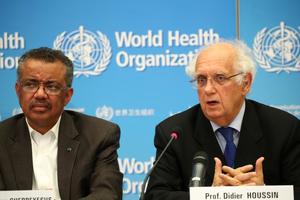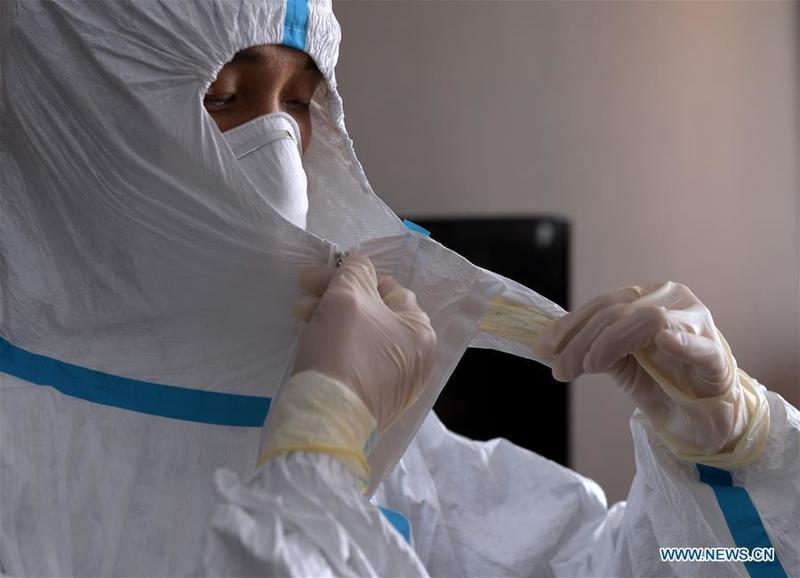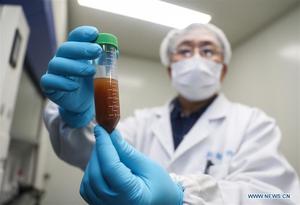 Didier Houssin, Chair of the Emergency Committee, speaks next to Director-General of the World Health Organization (WHO) Tedros Adhanom Ghebreyesus during a news conference after a meeting of the Emergency Committee on the novel coronavirus (2019-nCoV) in Geneva, Switzerland Jan 30, 2020. (PHOTO / AGENCIES)
Didier Houssin, Chair of the Emergency Committee, speaks next to Director-General of the World Health Organization (WHO) Tedros Adhanom Ghebreyesus during a news conference after a meeting of the Emergency Committee on the novel coronavirus (2019-nCoV) in Geneva, Switzerland Jan 30, 2020. (PHOTO / AGENCIES)
The World Health Organization on Thursday declared the novel coronavirus epidemic as a Public Health Emergency of International Concern, or PHEIC, after an emergency committee reconvened in Geneva, Switzerland, citing human-to-human infections have been confirmed in other countries.
Here are some key issues you may need to understand:
 A medical worker from Beijing Anzhen Hospital practices how to put on and take off protective clothing for preparations to join the fight against the novel coronavirus epidemic at a base for medical workers in Wuhan, capital of Central China's Hubei province, Jan 29, 2020. (PHOTO / XINHUA)
A medical worker from Beijing Anzhen Hospital practices how to put on and take off protective clothing for preparations to join the fight against the novel coronavirus epidemic at a base for medical workers in Wuhan, capital of Central China's Hubei province, Jan 29, 2020. (PHOTO / XINHUA)
How to define PHEIC?
A PHEIC is defined in the International Health Regulations (2005) as an extraordinary event which is determined to constitute a public health risk to other states through the international spread of disease and to potentially require a coordinated international response.
This definition implies a situation that is serious, unusual or unexpected; carries implications for public health beyond the affected state's national border; and may require immediate international action.
The responsibility of determining whether an event is within this category lies with the WHO director-general and requires the convening of a committee of experts – the IHR Emergency Committee. The committee makes a recommendation on whether to declare a PHEIC, but ultimately that decision rests solely on the director general's shoulders.
 Zhang Guimin (right) and Wu Wei, members of the medical team, gesture before they leave for Wuhan of Hubei province, in Qingdao, East China's Shandong province, Jan 30, 2020. (PHOTO / XINHUA)
Zhang Guimin (right) and Wu Wei, members of the medical team, gesture before they leave for Wuhan of Hubei province, in Qingdao, East China's Shandong province, Jan 30, 2020. (PHOTO / XINHUA)
What does a PHEIC entail?
With the PHEIC now in place, WHO will send a series of recommendations to member states aimed at controlling the spread of the disease and providing support to affected areas.
These will include recommending containment measures for health authorities, and possible future transport advisories designed to mitigate the cross-border spread of the disease while at the same time limiting disruption to travel and trade.
The WHO can recommend against border measures such as visa or import bans, border closures, flight cancelations and even passenger screening.
When a PHEIC is occurring, the WHO director-general shall issue temporary recommendations to member states, including placing suspected persons under public health observation; refusing entry of suspect and affected persons; implementing exit screening or restrictions on persons from affected areas; implementing treatment of the baggage, cargo, containers, conveyances, goods and postal parcels to remove infection or contamination; or even refusing their departure or entry.
 Members of a military medical team discuss the condition of a patient diagnosed with novel coronavirus (2019-nCoV) pneumonia in Wuhan, Central China's Hubei province, Jan 30, 2020. (PHOTO / XINHUA)
Members of a military medical team discuss the condition of a patient diagnosed with novel coronavirus (2019-nCoV) pneumonia in Wuhan, Central China's Hubei province, Jan 30, 2020. (PHOTO / XINHUA)
What are the precedents?
It is the sixth time that WHO has declared a PHEIC since the designation was adopted in 2005. Declarations were announced previously for the H1N1 flu pandemic in 2009, outbreaks of polio and Ebola in 2014, the Zika virus epidemic in 2016, and an ongoing Ebola epidemic in the Democratic Republic of Congo.
 A researcher of Stermirna Therapeutics Co, Ltd shows the experiment to develop an mRNA vaccine targeting the novel coronavirus in Shanghai, Jan 29, 2020. (PHOTO / XINHUA)
A researcher of Stermirna Therapeutics Co, Ltd shows the experiment to develop an mRNA vaccine targeting the novel coronavirus in Shanghai, Jan 29, 2020. (PHOTO / XINHUA)
How long do the PHEIC and temporary recommendations last?
Under the IHR (2005), temporary recommendations automatically expire three months after their issuance. Emergency committees are therefore reconvened at least every three months to review the current epidemiological situation and to review whether the event continues to be a PHEIC and whether changes need to be made to the temporary recommendations.


